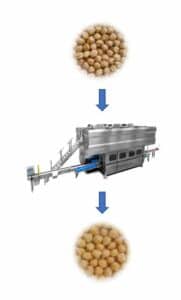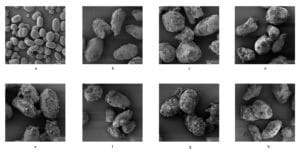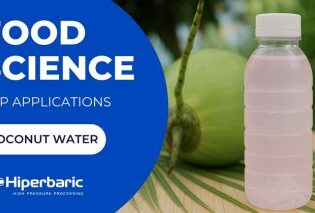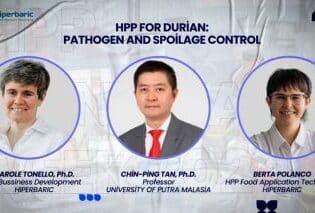

High pressure processing (HPP) is a non-thermal method for preservation of various foods while retaining nutrients. This original research unearthed the effects of HPP on the textural, nutritional, and antioxidant properties of cooked Australian kabuli chickpeas. Compared to the conventionally cooked chickpeas, HPP chickpeas had a more desirable texture (less firm), higher slowly digestible starch content and a concomitant decrease in rapidly digestible and resistant starch content. Increased starch digestibility was observed, with no effects to the protein digestibility values. These findings suggest that a functional, kabuli chickpea product with increased levels of beneficial starches can be produced using HPP.
High pressure processing (HPP) is an alternative to heat treatment for preserving foods and known to produce high quality and safe food with a longer shelf life due to reduction of food spoiling microorganisms. With an increase in
plant-based proteins worldwide, chickpeas are a widely available protein source, but the long cooking times make them a less appealing option. HPP can be used to produce a ready to eat chickpea product, however its effects on the textural, nutritional and bioactive properties of legumes are not well known. Thus, this research aimed to examine the effects of HPP on the textural, nutritional, and bioactive properties of cooked Australian Kimberley Large kabuli chickpeas. Chickpeas were exclusively acquired from the farmers of Kimberley region in Western Australia, followed by soaking (12 hours), cooking (30min), vacuum packaging and high pressure processing at 200/400/600 MPa for 1/5min giving 6 distinct samples (2K1, 2K5, 4K1, 4K5, 6K1 and 6K5) which were compared to non HPP treated chickpeas (control).

Followed by high pressure processing, all the simples including the control were analysed for their texture profile (firmness, chewiness, gumminess, springiness and cohesiveness), general nutrient composition including individual minerals, in vitro starch and protein digestibility, total polyphenol content and antioxidant properties (DPPH, ABTS and ORAC). Significant effects of pressure and treatment times were observed on texture profile. The firmness, cohesiveness, gumminess and chewiness values for high pressure processed samples was significantly lower than the control making HPP simples more desirable to consumers.
The general nutrient composition including individual minerals was unaffected by high pressure processing, however, the starch content of samples treated at 400 and 600 MPa was significantly lower than the control. The reduction in starch content sparked our curiosity to explore the starch macromolecules in a close manner. All simples including the control were freeze dried and starch globules were isolated from the freeze dried simples. Scanning electron microscopy (SEM) revealed that high pressure processing created fissures and damaged the starch globules with increasing treatment pressure and time leading to higher damage and possibly internal changes in the starch globule.

Following the scanning electron microscopy, Attenuated Total Reflectance- Fourier Transform infrared Scpectroscopy (ATR- FTIR) análisis was performed which revealed changes in the spectral region associated with starch (1200-1000 cm-1). A negative shift in the spectra was observed with increase in treatment pressure and an increase in treatment time lead to further negative incline in the spectra. The changes in the spectra of HPP samples associated with the starch clearly showed changes in the starch intermolecular structure. This was further confirmed by in vitro starch digestibility values for all samples. A significant increase in slowly digestible starch and a decrease in rapidly digestible and resistant starch values was observed for three high pressure treated samples (2K5, 6K1 and 6K5) clearly suggesting that high pressure processing leads to an increase in beneficial slowly digestible starch levels in chickpeas. No effect of HPP on in vitro protein digestibility were observed.
HPP also resulted in decrease in the total polyphenol content of samples treated at 600 MPa, whereas the DPPH antioxidant activity was significantly lower for samples treated at 400 and 600 MPa. The ABTS and ORAC antioxidant activity of sample treated at 600 MPa for 5 min was the lowest significantly different than all other samples including the control.
This study demonstrated that the textural and starch digestibility properties of cooked kabuli chickpea is significantly improved by the application of high pressure processing. Significant effects of treatment pressure and time on the starch, polyphenol and antioxidant capacity were also revealed. These combined findings highlight the potential of utilizing non-thermal processing technologies to increase consumer acceptance of plant- based protein sources with desirable textural properties. Our findings suggest that high pressure processing has the potential to enable the design of products with a low glycemic index, compared to traditional products, while retaining dietary fiber percentages, minerals and digestible proteins and thus providing beneficial health effects to consumers. However, the shelf stability of cooked + high pressure processed ready-to eat chickpea product is unknown and thus requires further research.
Image Gallery












